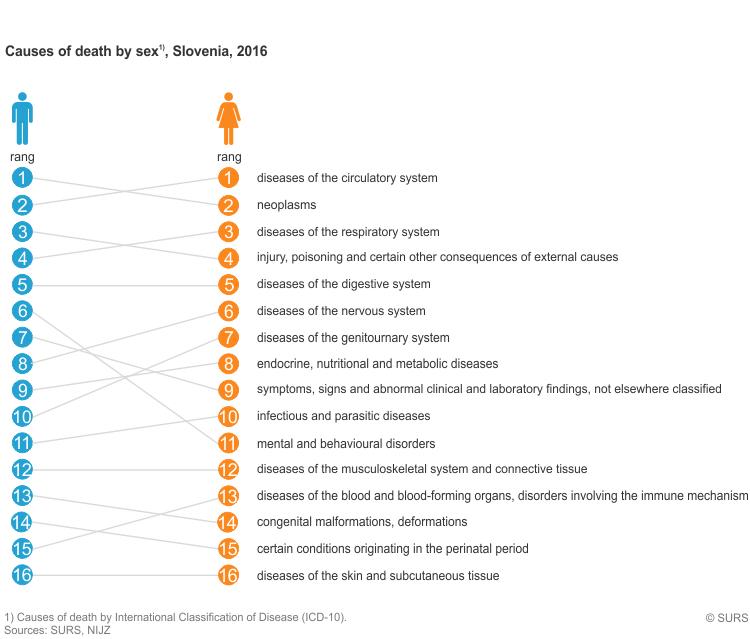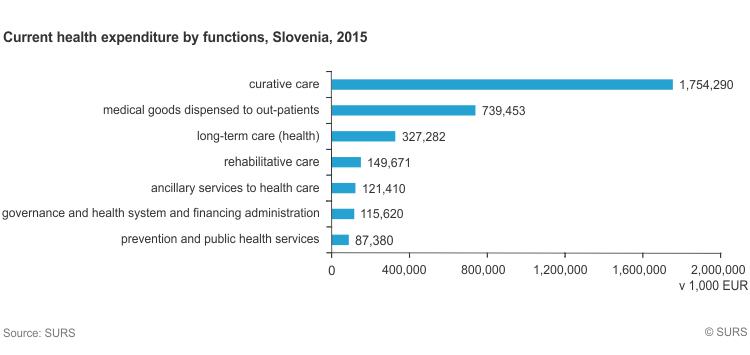
Slovenia assigns annually about 9% of its GDP to health, mostly for curative treatment and for medical goods. According to the self-assessment, in 2016 the overall health status was very good for a fifth of adults.
The purpose of the World Health Day, which is celebrated on 7 April, is to inform the public every year about a particular issue of health care. This year's slogan is "Health for All", and the day focuses on the universality and accessibility of health care, improving health for all and reducing health inequalities. Health is an important value, and the right to social security and health protection is one of the fundamental rights of an individual.
In Slovenia on average we spend 72% of our lives healthy, which is less than the EU average
According to the European structural Healthy Life Years indicator, which is based on individual limitations in normal activities, and thus represents the expected duration of life without disability, in Slovenia, on average, 72% of the lives are lived healthy (women 69%, men 75%), which is less than the EU average of 78% (women 76%, men 80%). For all EU Member States this indicator is characterized by a fairly high difference between men and women, largely due to the lower life expectancy of men.
According to the self-assessment, the overall health status of a fifth of adults is rated as very good; men are more optimistic
The Survey of Income and Living Conditions 2016 showed that the opinion of two-thirds of persons aged 16 or more in Slovenia was that their overall health status was good or very good (44% good and 20% very good); men were slightly more optimistic than women. Self-assessment was of course strongly conditioned by age; 89% of people aged 16–25 years assessed their health status as good or very good, while among those aged 66 or more the share was slightly less than a third.
On average, employees on sick leave for 14.5 calendar days
In 2016, women were on average on sick leave about 18 calendar days and men about six days less. The majority of men were on sick leave during this year due to injuries (four calendar days), while the majority of women who were on sick leave suffered from musculoskeletal and connective tissue disorders (also four calendar days).
Diseases of the circulatory system (cardiovascular diseases) and various cancers the most common causes of death
In 2016, diseases of the circulatory system (cardiovascular diseases) and various cancers (i.e. neoplasms) were the most common causes of death in Slovenia, namely in almost three-quarters of deaths. Gender differences were quite significant: women got sick and died predominantly due to diseases of the circulatory system (in almost half of the cases), while men got sick and died predominantly due to various cancers (in more than a third of cases).
Current health expenditure according to latest available data amounted to 8.5% of GDP
According to the latest data collected for 2015, current health expenditure (excluding investments) amounted to 8.5% of GDP (or EUR 3.3 billion), which ranks Slovenia 13th among the EU-28 Member States with data collected in accordance with an internationally comparable methodology of health accounts. The largest share of GDP (around 11%) was allocated to health care by Germany, Sweden and France, while a half less or the lowest share was recorded by Luxembourg, Latvia and Romania (between 5 and 6%).
With contributions from compulsory health insurance, this year we collected 69% of all money in Slovenia, 15% from voluntary (complementary) health insurance, 13% with out-of-pocket payments of individuals and rest 3% from other sources.
Every year, most of the funds for services of curative treatment and for medical goods
In 2015, in Slovenia, most funds (EUR 1.8 billion) were used for services of curative care and the least (EUR 87 million) for prevention and public health services.
Out-of-pocket health expenditure lower than in most other countries
Financial access to health services is usually influenced the most by out-of-pocket expenditure: it can be a huge financial burden for the poorer households as it is unpredictable, and is the greatest burden on chronic patients and the elderly. In Slovenia, these expenditures are still relatively low (13% in 2015; in the EU on average 22%), since most health services, medicines and medical devices are covered by compulsory and voluntary (complementary) health insurance. Voluntary (complementary) health insurance allows access to a large basket of goods for all insured persons, thereby contributing significantly to solidarity between healthy and sick people and between young people and the elderly in financing private health expenditure. According to the latest available data, in 2015 most out-of-pocket expenditure was spent for medicines and medical devices (56%), followed by expenses for outpatient curative care: for general outpatient curative care 7%, by 8% each for dental services and for specialised outpatient curative care and 13% for other outpatient curative care (physiotherapy, etc.).





































































